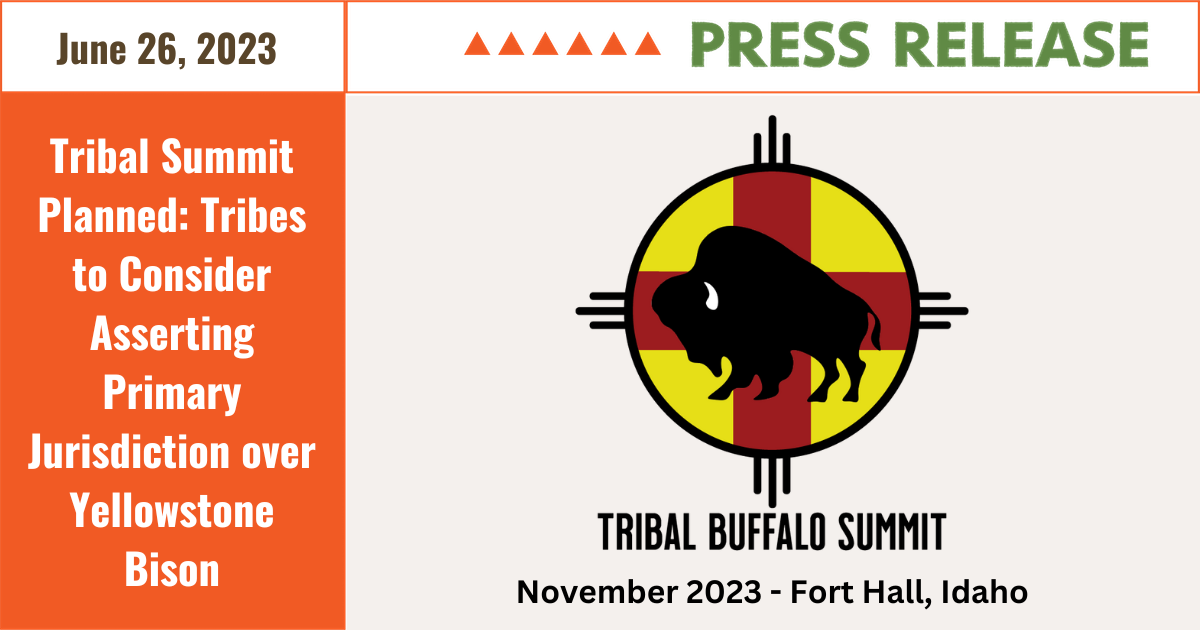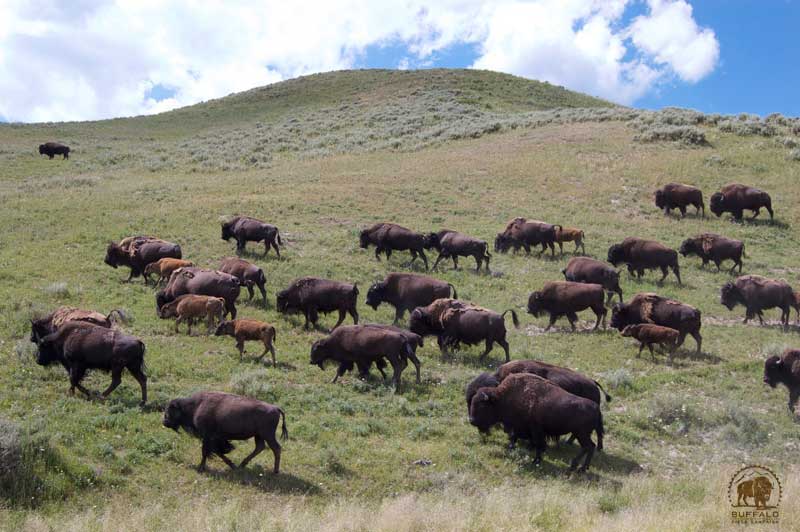Tribal Summit Planned November 2023 - Fort Hall, Idaho
Contacts
James Holt, Executive Director
This email address is being protected from spambots. You need JavaScript enabled to view it.
208-791-3306
J. Dallas Gudgell, Board Member
This email address is being protected from spambots. You need JavaScript enabled to view it.
208-914-5194
West Yellowstone, MT - As the U.S. Fish & Wildlife Service considers the need to list Yellowstone Bison as a threatened or endangered species, there is a growing momentum among the interested Tribes to assert their inherent jurisdiction over wild buffalo and usher in a new era of stewardship over America’s national mammal. According to Nez Perce environmental scientist James Holt, the executive director of Buffalo Field Campaign, such an historic agreement between sovereign nations working with federal stewards would represent nothing less than the beginning of “true reparations” for the long-standing practice of cultural genocide, or ethnocide, that is still being perpetuated by the cattle industry to preserve their monopoly on public lands forage in the West.

“Tribal cultures and lifeways depend on repairing our sacred relationship with buffalo,” says Holt, “and restoring honorable harvest of wild bison is being severely hampered by the limited populations of Yellowstone Bison, together with the onerous conditions placed upon the hunt by Montana’s Department of Livestock.”
In an effort to invoke the sovereign supremacy accorded only to Tribes and the federal government under the U.S. Constitution, Holt and Buffalo Field Campaign are calling for a Tribal Summit to be held in Fort Hall this November. The invitation to 31 Tribes calls for replacing “the existing failed bison management plan with a historic agreement that appropriately honors the fiduciary responsibility of the United States to Tribes.”
Specifically, the Tribes are to consider endorsing a “holistic co-stewardship model [that] would be ecosystem-wide, population-based, [would] honor treaty-reserved rights, continue to facilitate on-reservation restoration via the Ft. Peck Program, be co-created among tribal sovereigns, and [would] respect the participation of all [] Yellowstone-affiliated tribes.”
Summit organizer J. Dallas Gudgell, an environmental scientist originally from the Fort Peck Reservation, maintains that sovereign supremacy is the only viable way forward for Yellowstone Bison. “We’re currently operating under a plan that perpetuates colonialism and oppression by encouraging the Tribes to compete with one another for a severely and artificially limited resource,” Gudgell says.
“It is in the interest of the Tribes and the Buffalo for Tribes to cooperate with one another instead, based upon their common spiritual and cultural interests” Gudgell continued, “and to work together with the Buffalo to expand the Yellowstone population from 5,000 to 50,000 by restoring their natural migrations into the Greater Yellowstone Ecosystem, which is largely National Forest lands, rather than cutting those migrations off with canned hunts, as Montana currently does in the sole interest of culling the herd.”

Bison Conservation Initiative & State Interference
The call for expanding wild bison populations in the larger ecosystem is directly responsive to Secretary of Interior Deb Haaland’s restoration initiative embodied in Secretary’s Order No. 3410 (PDF), which was jointly adopted by the Department of Agriculture, responsible for managing the National Forests surrounding Yellowstone National Park. In announcing the plan, Haaland pointed out that while the overall recovery of the bison has been a success, wild bison are still “functionally extinct to both grassland systems and the human cultures with which they coevolved,” and thus “significant work remains” to get the Tribes more bison.
According to Holt, the only viable way of supporting the conservation herds Haaland is promoting is by strengthening the genetic pool represented by Yellowstone Bison. That position echoes Interior’s 2020 Bison Conservation Initiative, which is premised upon a "commitment to both leadership and partnership to ensure the conservation and restoration of wild American bison.” While Interior prefers to partner with both states and Tribes in accomplishing bison restoration, Holt points out that the state of Montana, constrained by the policies of its current governor, has disqualified itself from participation in the program.
“The Supreme Court has made it clear that state interests are limited to conservation,” Holt says. “Montana doesn’t even recognize buffalo as wildlife, and Governor Gianforte characterizes them as a detriment to other wildlife, which directly contradicts science that sees bison as a keystone species,” Holt said.
While Montana continues to discriminate against Yellowstone Bison on the grounds that some of them carry brucellosis, a bacteria that can cause cattle to prematurely abort fetuses, migrating elk also carry the bovine disease, and regularly infect cattle in the ecosystem. Bison have never transmitted brucellosis to cattle, and cattle are rarely turned out on public lands in the springtime, which is the only time transmission from bison would be possible. While cattlemen fear competition for forage from bison, science has shown that bison actually restore grasslands and biodiversity, and would thus likely result in more, not less, forage (and water) being available for cows.
The Park Service, an agency of the Department of Interior, terminated its’ prior joint analysis with the State of Montana over the state’s intransigence and unwillingness to follow science in updating the management regime for Yellowstone’s buffalo. The Park Service and State had previously agreed that brucellosis is endemic in Yellowstone’s ecosystem, is transmitted to cattle by elk, and that the risk of transmission from bull bison to cattle is negligible, if not scientifically precluded.
“There is no scientific basis for managing bison differently than elk,” Holt maintains. “And the legislature’s recent opposition to re-introducing wild bison into the Charles M. Russel Wildlife Preserve clearly shows that their concern is over competition with cattle, not brucellosis.”
With buffalo populations growing naturally in the Park, and new research that discounts any perceived threat they pose to cattle in Montana, Yellowstone Park’s Superintendent Cam Sholly has already signaled the Park Service’s preference for managing buffalo more like elk in the Greater Yellowstone Ecosystem, including the Custer-Gallatin National Forest in Montana.
According to Gudgell, until a state recognizes Yellowstone Bison as wildlife and asserts a legitimate interest in conservation, their appropriate role in any developing co-stewardship management program would be limited to the right of consultation.
“We intend to cooperate with the states to the extent necessary to protect the economic interests of private landholders,” Gudgell said."The Tribes could employ range-riders to further cultural connections and monitor the expanding herd,” according to Gudgell. “The only conflicts we anticipate are political,” Gudgell said, “and this recovery process will be guided by science, not politics.”
“There are only two sovereign powers that have authentic jurisdiction over America’s buffalo,” Gudgell concluded, “sovereign Tribes and the federal government.”
According to a recent article in the Wyoming Law Review, “Re-Indigenizing Yellowstone,” the Park Service has ample authority and every reason to enter into co-management agreements with the Tribes to protect Yellowstone’s wildlife without regard to Park boundaries.

Yellowstone Bison’s Role in Climate Mitigation
BFC’s Executive Director Holt is one of over a hundred signatories to the Inter-Tribal Buffalo Treaty, which the Park Service and the Department of Interior are actively supporting. Holt says the time has now come for Yellowstone’s treaty Tribes to assert their inherent, un-ceded rights in relation to America’s free-roaming wild buffalo.
“We have never surrendered our aboriginal rights to co-exist on unoccupied lands with our Buffalo brothers and sisters,” Holt said. “And unlike the state of Montana, Tribes are willing and able to help take care of the buffalo, just as my Tribe has done for salmon, using the best science and our own traditional ecological knowledge,” Holt asserted.
Buffalo are considered a keystone species by leading ecologists, because their presence on the land has cascading benefits for both plants and animals. According to the most recent science informing the adoption of a new international biodiversity pact, “Large mammals,” specifically including Yellowstone’s wild bison, “serve as landscape engineers, shaping the structure and composition of natural habitats.” See: Vynne, et al., “An ecoregion-based approach to restoring the world’s intact large mammal assemblages” (Ecogoraphy, 2022).
In fact, according to this study of biodiversity, “twenty species, if reintroduced or allowed to recolonize through improved connectivity” would increase global biodiversity by 54% (4.3M sq. mi.). According to the authors: “Intact ecosystems are recognized for their exceptional value in conserving biodiversity, stabilizing the climate, sustaining livelihoods of indigenous peoples and providing essential services for humanity.”
Bison can also be characterized as a “climate keystone species.” A recent study on holistically planned grazing revealed the staggering carbon sequestration potential associated with restored grasslands. When applied to up to five billion hectares of degraded rangelands and agricultural soils on former wild grasslands, ten or more gigatons of excess atmospheric carbon could be returned to soils annually. This is roughly twice the amount of current annual emissions in the U.S., and a third of global emissions.
As a featured article in the Washington Post (Jess McHugh, 7/13/22), characterizing bison as “Climate Heroes,” points out:
The return of the bison is a victory not only for the sake of biodiversity but for the entire ecosystem in which they live. As a keystone species, the bison sustain their environment from the top down. “They move through, graze everything down. It’s a type of disturbance — like fire would be,” said [biologist] Dan McDonald. “The fresh green draws other animals that would feed on it: elk and deer and whatever other type of grazers that would consume some of that new forage.” When large herds move synchronously across the land, they create what scientists have dubbed a “green wave.” The bison’s vigorous grazing stimulates plant growth, creating a flood of new vegetation that follows in the bison's wake to be "surfed” by animals large and small. Green waves can be so dramatic that some — such as the one created by Yellowstone’s bison herd — can be seen from space.
But as the Post article goes on to point out, “holistic herd management techniques spearheaded by tribes operate on this principle: Bison are wildlife — not livestock. These animals require lots of land to maintain ecological balance…”
By bringing the Tribes together to assert their inherent jurisdiction over Yellowstone Bison, Buffalo Field Campaign intends to give buffalo the room to roam that they require to benefit Tribes, grasslands, and to help reverse global warming.
Download the Tribal Summit Invitation (PDF)
Download the Tribal Summit Legal Narrative (PDF)







